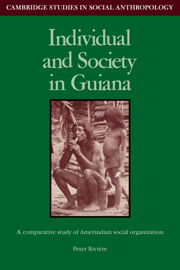Book contents
- Frontmatter
- Contents
- Acknowledgments
- 1 Peoples and approaches
- 2 The settlement pattern: size, duration, and distribution
- 3 Village composition
- 4 The categories of social classification
- 5 Aspects of social relationships
- 6 Autonomy and dependency
- 7 The individual in society
- 8 Guiana society and the wider context
- Notes
- Bibliography
- Index
- CAMBRIDGE STUDIES IN SOCIAL ANTHROPOLOGY
1 - Peoples and approaches
Published online by Cambridge University Press: 01 October 2009
- Frontmatter
- Contents
- Acknowledgments
- 1 Peoples and approaches
- 2 The settlement pattern: size, duration, and distribution
- 3 Village composition
- 4 The categories of social classification
- 5 Aspects of social relationships
- 6 Autonomy and dependency
- 7 The individual in society
- 8 Guiana society and the wider context
- Notes
- Bibliography
- Index
- CAMBRIDGE STUDIES IN SOCIAL ANTHROPOLOGY
Summary
This work has three aims, all of which reflect the present state of ethnographic research in Lowland South America. Although late as an area to receive intensive ethnographic attention, this lateness has not lacked its advantages. Untrammeled by the deadweight of earlier works cast in outmoded anthropological fashions, the ethnography of the area has been characterized in the past decade by an enormous vitality, not only in the quantity of its production but also in the quality of its ideas. It is time to take stock of what we have got and where we stand before pushing on. In a small way, and with reference to only part of the area, this book is intended to be a contribution to that stocktaking.
These remarks are as true for the Northeast region of Lowland South America as they are for the area as a whole, and it is on this region, referred to as “Guiana” and more closely defined below, that attention is focused. Although early accounts by missionaries, travelers, and scientists are often valuable and informative documents, and indeed are the sources for Roth's masterly and comprehensive surveys (1915, 1924, 1929), intensive anthropological fieldwork in the region dates only from the 1930s with Gillin's study (1936) of the Barama River Caribs. After that there was a slight hiatus until Butt, Fock, and Yde started work in the 1950s. Their publications heralded a spate of works that has continued until the present. There is evidence to suggest that we are about to enter a lull in this activity, and, even if this is not so, the time seems ripe to attempt an overview of the rich information now available.
- Type
- Chapter
- Information
- Individual and Society in GuianaA Comparative Study of Amerindian Social Organisation, pp. 1 - 14Publisher: Cambridge University PressPrint publication year: 1984



